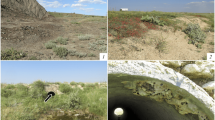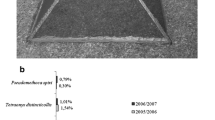Summary
Vespa dybowskii André can establish the nest either by the independent foundation like as other hornets, or by the usurpation of the nests ofV. crabro L. orV. xanthoptera Cameron already established. Namely, this hornet belongs to the facultative temporary social parasite like asVespula squamosa (Drury) and certain bumblebees. The marked aggressiveness of this hornet and other biological observations were described together with some considerations on the labour parasitism among the social insects.
Zusammenfassung
Vespa dybowskii André kann ihre Nest falls durch die unabhängige Gründung wie andere Hornisse, falls aber durch die Oberung der schon gegründeten Nester vonV. crabro L. oderV. xanthoptera Cameron, gründen. Nämlich gehört diese Hornis zum fakultativen temporären Sozialparasit wieVespula squamosa (Drury) und gewisse Hummelarten. Die bemerkbare Kampflustigkeit dieser Hornisse und andere biologische Beobachtungen wurden zasammen mit einige Betrachtungen über die Arbeitsparasitismus in den sozialen Insekten beschrieben.
Résumé
Vespa dybowskii André nidifie soit en construisant elle-même son nid comme les autres guêpes, soit en usurpant des nids deVespa crabro L. ouV. xanthoptera Cameron déjà construits. Cette guêpe appartient donc aux
Similar content being viewed by others
Literature Cited
1940.Bequaert (J.). — An introductory study ofPolistes in the United States and Canada with descriptions of some new North and South American forms (Hymenoptera; Vespidae). (J.N.Y. Entom. Soc.,48, 1–30).
1926.Eidmann (H.). — Die Koloniegründung der einheimischen Ameisen (Zs. vergl. Physiol.,3, 776–826).
1930.Frison (T. H.). — A contribution to the knowledge of the bionomics ofBremus americanorum (Fabr.). (Ann. Entom. Soc. Amer.,23, 644–665).
1953.Gœtsch (W.). — Vergleichende Biologie der Insekten-Staaten. 2. erneut. Aufl., Leipzig.
1937.Gœtsch (W.), Kaethner (B.). — Die Koloniegründung der Formiciden und ihre experimentelle Beeinflussung. (Zs. Morph. Oekol. Tiere,33, 201–260).
1932.Goesswald (K.). — Oekologische Studien über die Ameisenfauna des mittleren Maingebietes. (Zs. wiss. Zool.,142, 1–156).— 1933.Goesswald (K.). Ueber Grundsätzliches über parsitische Ameisen unter besonderer Berücksichtigung der abhängiger Koloniegründung vonLasius umbratus mixtus Nyl. (Ibid. Zs. wiss. Zool.,151, 101–148).
1953.Hasegawa (T.). — Systematic studies on Vespinæ of Japan (In Japanese, unpubl. dissertation).
1940.Hediger (H.). — Zum Begriff der biologischen Rangordnung (Rev. Suisse Zool.,47, 135–143).
1936.Maa (T.). — Nesting and flower-visiting habits of certain bees and wasps of E. China I. (Entom. & Phytopathol.,4, 59–68,in Chinese).
1934.Plath (O.). — The bumblebees and their ways, New York.
1935.Reinig (W. F.). — On the variation ofBombus lapidarius, L., and its cuckoo,Psithyrus rupestris Fab., with notes on mimetic similarity (J. Genetics,30, 321–356).
1927.Richards (O. W.), — The specific characters of the British humblebees (Hym.), (Tr. Entom. Soc. Lond.,75, 233–266).
1954.Shida (T.). — The life of a common wasp,Vespula lewisii (Cameron), (Lec. at 3. Ann. Meet., Jap. Sec., U. I. I. S., Tokyo).
1939.Taylor (L. H.). — Observations on social parasitism in the genusVespula Thomson (Ann. Entom. Soc. Amer.,32, 304–315).
1937.Weyrauch (W.). — Zur Systematik und Biologie der Kuckuckswespen,Pseudovespa, Pseudovespula undPseudopolistes (Zool. Jb., System.,70, 243–290).— 1938.Weyrauch (W.). Nachtrag zu meiner Arbeit über Pseudovespinen und Pseudopolistinen (Zool. Anz.,121, 33–37).
1919.Wheeler (W. M.). — The parasitic Aculeata, a study in evolution (Tr. Amer. Philos. Soc.,58, 1–40).
1955.Yoshikawa (K.). — A polistine colony usurped by a foreign queen. Ecological studies of Polistes wasps II. (Ins. Soc.,2, 255–260).
1949.Zikán (J. F.). — O gêneroMischocyttarus Saussure (Hym., Vespidæ) com a descrição de 82 espécies novas (Parq. Nacion. Italiaia, Bol. Nr. 1, 1–251).
Author information
Authors and Affiliations
Additional information
Contribution No. 359 from the Zoological Institute, Faculty of Science, Hokkaido University, Sapporo, Japan.
We are much indebted to Professor TohruUchida for reading the manuscript, and to Dr. KeizoYasumatsu who gave us kindly valuable informations on this species. Moreover, we express here our gratitude to Dr.G. Richard for his kindness in preparing French summary.
Rights and permissions
About this article
Cite this article
Sakagami, S.F., Fukushima, K. Vespa dybowskii André as a facultative temporary social parasite. Ins. Soc 4, 1–12 (1957). https://doi.org/10.1007/BF02226244
Issue Date:
DOI: https://doi.org/10.1007/BF02226244




